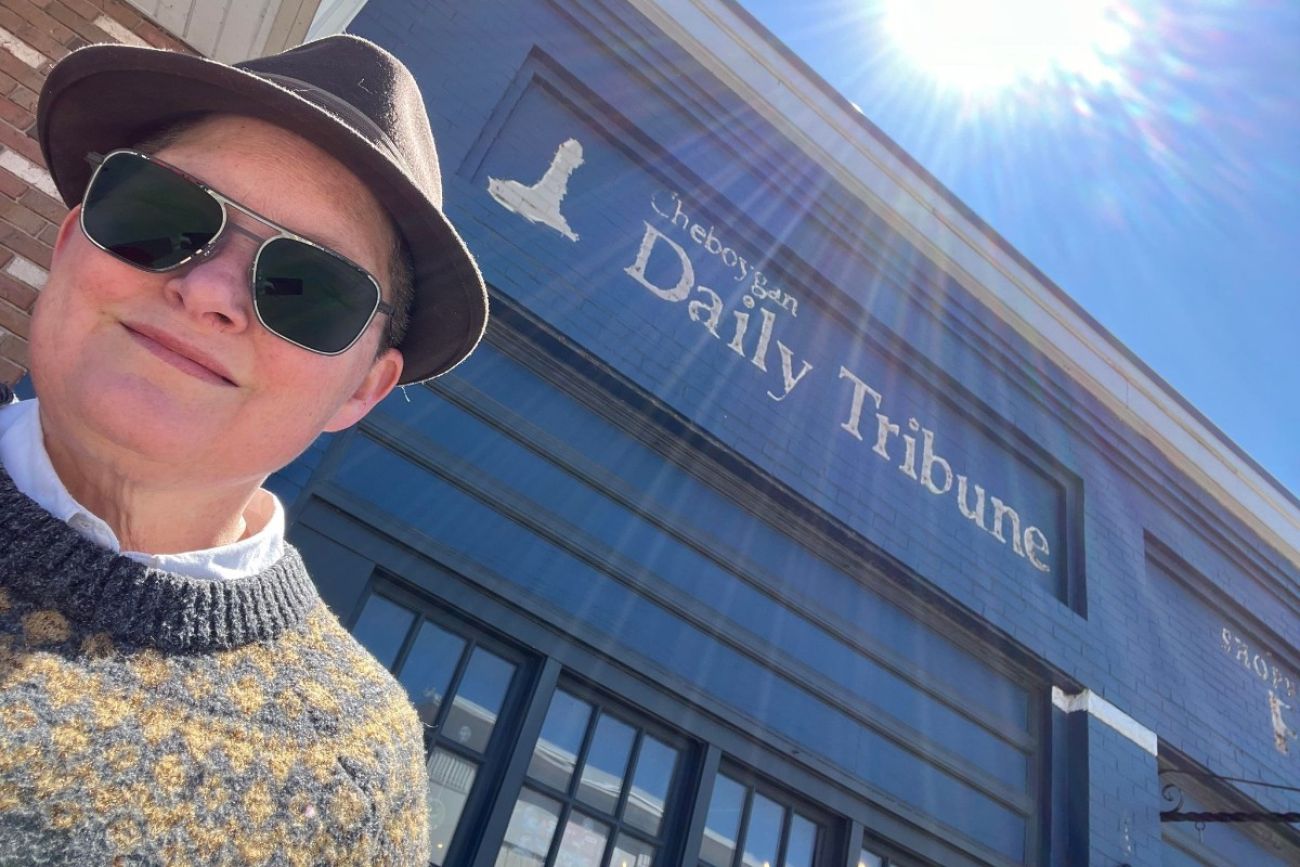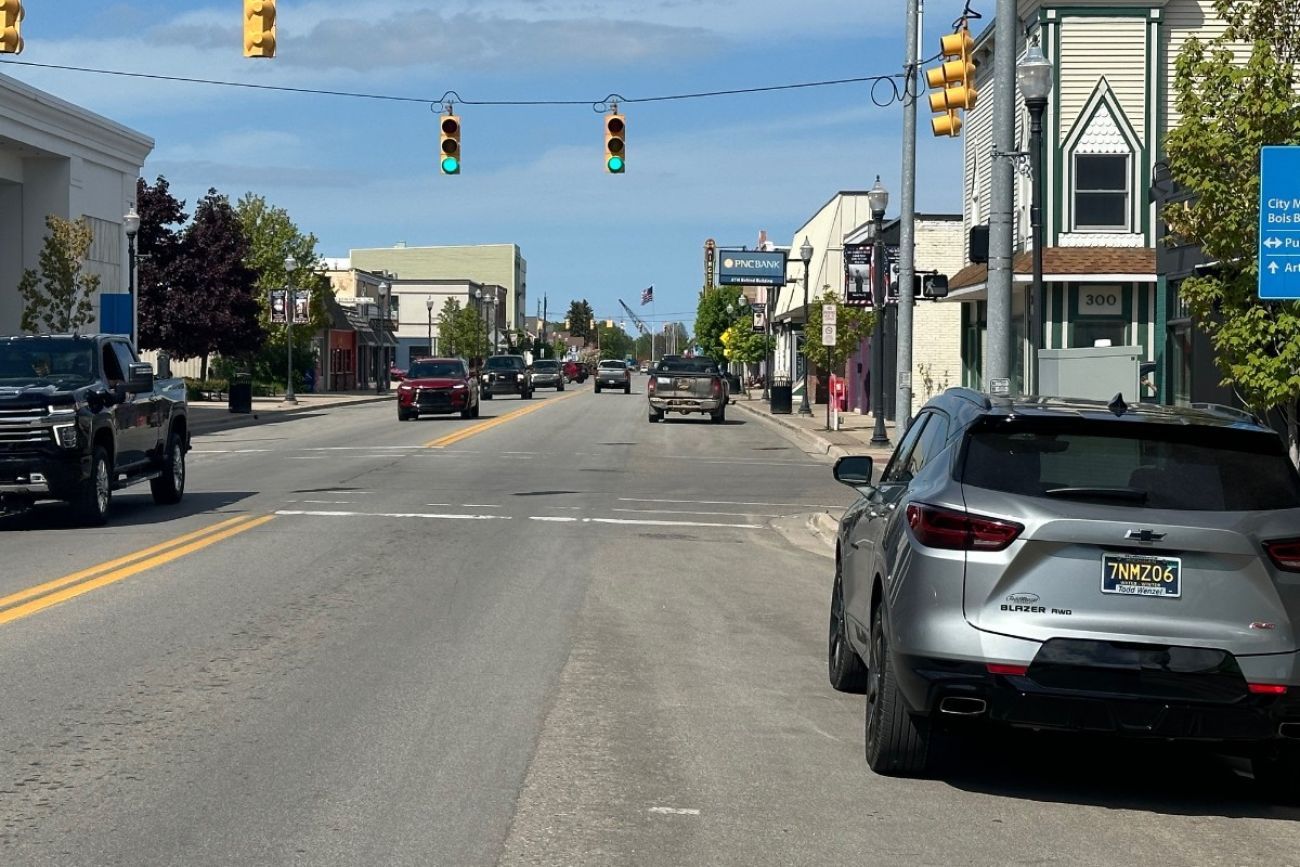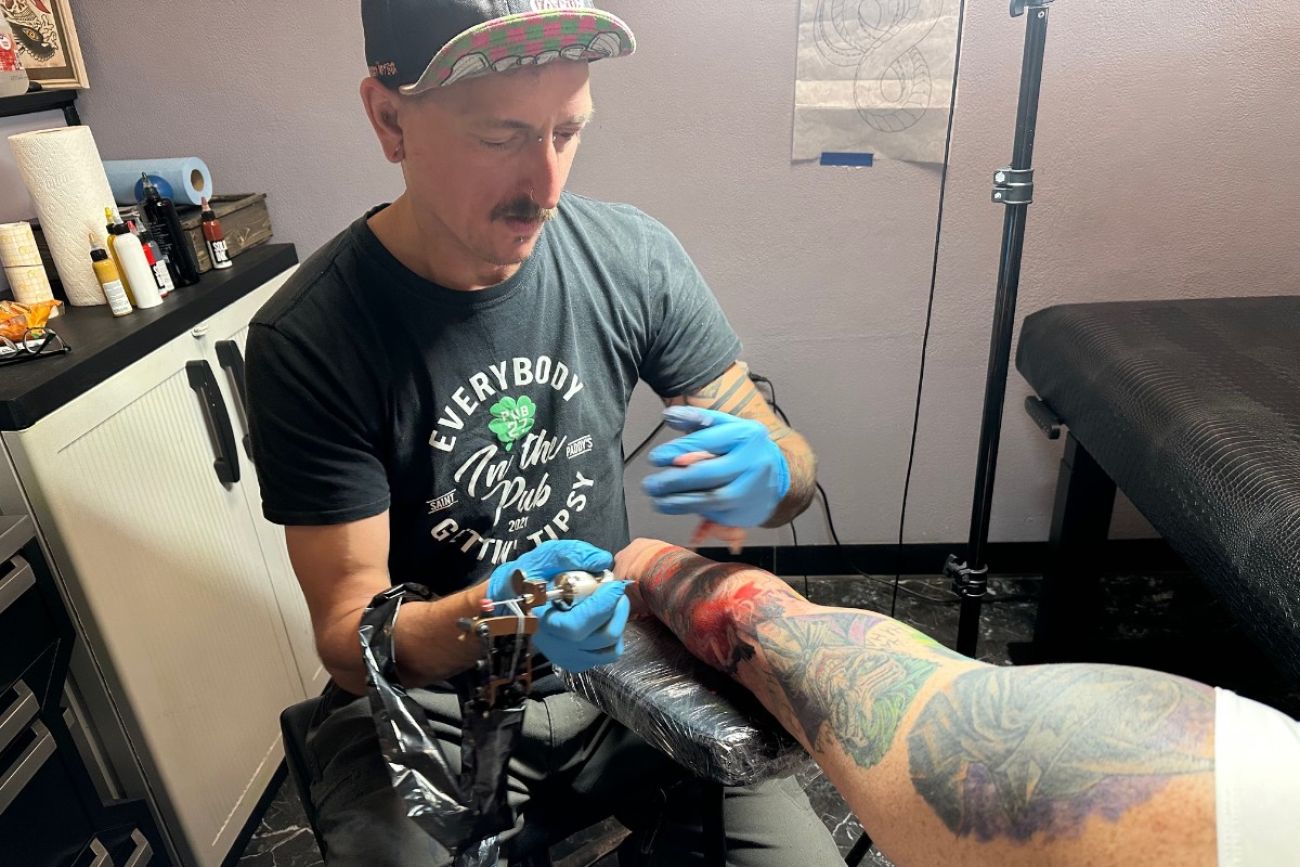Michigan town adjusts to life with ‘ghost newsroom,’ as local papers wither

- Cheboygan’s newspaper no longer has a journalist to cover news in the Up North community
- Residents now turn to Facebook posts to keep up with local happenings
- Lack of journalists in Cheboygan and other Michigan communities make it difficult to know what government is doing
CHEBOYGAN --- They painted over the Cheboygan Daily Tribune sign last week, the letters loaded into the back of a pickup truck and the dark blue bricks disappearing under a coat of fuchsia. Inside the old Main Street building, where once reporters pecked away on stories about the city council, there’s now a shop selling medieval goods and swords.
“We have the largest selection of battle-ready weaponry you can find,” said Joe Heythaler, proprietor of the Enchanted Knights store.

The local newspaper still exists online and residents can grab a thin printed copy at Family Fare Supermarket, but the stories within it often aren’t focused on Cheboygan.
The Daily Tribune employs one sports reporter, but no local news reporters to report on happenings in this Lake Huron community, 15 miles southeast of Mackinaw City, leaving residents to scour Facebook and a weekly shopper publication for information on elections and tax increases.
Related:
- Cruising the Great Lakes: 20,000 passengers expected to set sail in '24
- Michigan has plenty of jobs. Too bad workers find so many boring, study finds
- With Flint megasite deal, Michigan tops $1B in spending on development land
Heythaler appreciates the irony of a business focused on bygone times locating in a building where newspaper presses gather dust.
“It’s a dying media,” said Heythaler, in his medieval tunic.
“People still show up here (to the old office), saying ‘I have an obituary here,’ or ‘My daughter was in a sporting event and I want to pick up some extra copies,” he said. “I send them to the Speedway, they still sell it.”
Throughout Michigan and the nation, weekly and daily newspapers that once served as the lifeblood of communities are closing or, as in Cheboygan, becoming “ghost papers” with few or no journalists.
In those communities, residents sometimes struggle to keep up with local news that impacts their lives far more profoundly than news that’s easy to find on Fox or social media.
“The chronicling of a small town, that historic record-keeping, has faded,” said Jill Josef Greenberg, a former employee at the Cheboygan paper.
“I wonder who will tell the story of these resilient people?”

Less information, higher costs
There are about 6,000 newspapers remaining in the United States. Most of them, 4,790, are weeklies, according to a report by Northwestern University’s Medill School of Journalism.
As recently as 2005, there were 8,891 newspapers.
About 30 newspapers have closed in Michigan since 2016, according to the Michigan Press Association, with about 175 remaining.
“Newspapers are the cornerstone of a community,” said Lisa McGraw, MPA’s public affairs manager.
“They provide reliable information to citizens about elections, local government, the school board, and everyday information like sports scores and school lunch schedules.
“And when it comes to democracy, it’s information about who’s running (for local offices), what their record is, who they are.”
When a paper closes or is gutted like the Cheboygan publication, residents can be left on their own to find information on the Internet. There may also be a financial cost. Some academics have linked the closure of newspapers to higher rates for municipal bonds. That’s because they were considered a higher risk “because they're worried that local government maybe could run roughshod without oversight,” said MPA Executive Director James Tarrant.
‘Ghost newsroom’
A decade ago, Cheboygan’s downtown was virtually a ghost town. Today, recently empty storefronts are filled with gift and apparel shops. In a town of about 4,700 people, there are three ice cream shops along Main Street.
One business that isn’t thriving is the town’s newspaper.

The paper slowly withered over decades, suffering from the same decrease in paid circulation as newspapers across the country as readers opted for free information online. Then in 2022, Gannett announced a round of 400 layoffs at its newspapers across the nation, with the last Daily Tribune news reporter among the victims.
By the time the last news reporter closed her laptop, the paper was down to a circulation of about 1,400.
Sherrie Wright, who operates Bittersweet gift shop across Main from the former home of the Daily Tribune, described the online navigating she now goes through to try to keep abreast of community news.
The city posts information on their official website, Wright said, as does the Cheboygan Area Chamber of Commerce. She can’t remember the last time she picked up a Daily Tribune, she said. It’s one less thing that residents share.
“It’s a cohesiveness, whether it’s good or bad, a common denominator that’s just not there anymore,” Wright said.
The Daily Tribune still has sports stories and occasional news stories about the community written by reporters based in Gaylord or Petoskey, two publications owned by the same media company that owns the Daily Tribune, Gannett.
The paper’s website includes one contact for news, Kortny Hahn. But the email listed for Hahn no longer works and the social media account linked on the website hasn’t been updated since 2016.
In reality, Hahn was laid off in August 2022. She now works in the optical department of a Walmart in Petoskey.
Hahn worked at the paper for almost 10 years before being laid off. “I was told corporate had a bad quarter and my position was dissolved,” she told Bridge. “I’ve told them to take (my name and contact) off (the website) but it’s still there.”
Sarah Leach supervised the Cheboygan newspaper and 14 others in Michigan until earlier this month, when she was fired by Gannett after speaking out about the impact of staff shortages.
She calls Cheboygan a “ghost newsroom,” that exists online but no longer has any news reporters. A second Gannett newspaper in the state, the Sturgis Journal, also has no news reporters, Leach told Bridge.
“We don’t really talk about it in media companies,” Leach said. “It’s an embarrassment for a lot of companies, because they don’t really have a clear answer as to how to solve that problem.”
A spokesperson for Gannett responded to a request for comment for this story with the following statement: "The Cheboygan Daily Tribune has deep roots in the Cheboygan County community and we remain committed to providing resources to our newsroom and continuing to leverage our USA TODAY Network for continued coverage."
Cheboygan residents noticed the difference quickly. In late 2022, both the city council and the Cheboygan County Board of Commissioners groused about the fact that no one was reporting to the public about their meetings.
“People knew about stuff faster when we used to have a reporter at most meetings,” said Richard Sangster, a county commissioner and former Cheboygan mayor. “One of the biggest concerns is to get general information out to people, who used to use (the local paper) as their primary source.”
Sangster’s biggest worry: how residents will get information about local political candidates.
“I’m running again, and I have a challenger in the primary,” he said. “There’s a sheriff’s race that is the big one in the county. And there’s a challenger for the 106th state rep. Absentee ballots are going out next month, that’s not very far away, and people don’t know who’s running.”
“My biggest fear is that the public doesn't understand what it's missing,” Leach said. “It doesn't know what it doesn't know. And that just leads to obvious opportunities for corruption in so many different ways, and then you literally have democracy at stake.”
Without local news coverage, it’s tough for residents to know what’s going on with government, said Ben Dratnal, owner of Ninja Monkey Tattoo and Piercing.
Several residents who spoke to Bridge said they were unaware of a water rate increase until it took effect.

Dratnal said many residents now get their local news from the Cheboygan Area Rant and Rave & More Facebook page, which on a recent day featured posts from residents complaining about someone not clearing their trash at a local fast food restaurant, to Family Fare weekly sales and job openings at the town’s Tractor Supply Co. store.
“When is a meeting going to be? What’s on the agenda? When you have to rely on Facebook, it always ends up being suspect,” Dratnal said.
Greenberg worked at the Daily Tribune in the 1990s, when, by their recollection, there was a staff of about 15 people, some of them local celebrities.
“There was Gordon Turner, who spent nearly 70 years there,” said Greenberg, who now is a spokesperson for the Michigan Department of Environment, Great Lakes and Energy, and lives in Lansing.
“He typed out his stories on an old Remington typewriter, and there was a woman whose sole job was to type his stories into the computer. He’d write about the snowmobile races and go around measuring sunflowers to see which was the tallest one in town.
“These are the things that pull little communities together,” Greenberg said. “If your kid’s softball team wins a tournament, you know you can slip a quarter in (a newspaper box) and grab a couple extra copies.
“It’s inevitable that there’s a loss of identity in a community” when a newspaper loses its reporters, she said.
Facebook and digital signs
Statewide, there are signs of hope. Several individuals have purchased small newspapers or chains of newspapers to keep them alive. And there’s a growing number of online-only publications serving local and statewide audiences, ranging from partisan bloggers to newsrooms staffed with trained journalists.
In the past year, Cheboygan community leaders have held meetings trying to figure out ways to get news to the public, said Carole Yeck, executive director of the Cheboygan Area Chamber of Commerce.
While the city and the chamber put information online, “a lot of people (in primarily rural Cheboygan County) don’t have Internet to see that stuff,” Yeck said.
One idea being discussed: installing a digital sign that could flash information about events and meetings to passersby on Main Street.
Meanwhile, in the former Daily Tribune office, the staff of Enchanted Knights is searching for a home for three heavy old pieces of printing equipment so they can use the space for Dungeons & Dragons tournaments.
They’ve checked with a newspaper museum in Chicago, but the museum wasn’t interested.
It turns out there’s a glut of newspaper detritus across the country.
Business Watch
Covering the intersection of business and policy, and informing Michigan employers and workers on the long road back from coronavirus.
- About Business Watch
- Subscribe
- Share tips and questions with Bridge Business Editor Paula Gardner
Thanks to our Business Watch sponsors.
Support Bridge's nonprofit civic journalism. Donate today.
See what new members are saying about why they donated to Bridge Michigan:
- “In order for this information to be accurate and unbiased it must be underwritten by its readers, not by special interests.” - Larry S.
- “Not many other media sources report on the topics Bridge does.” - Susan B.
- “Your journalism is outstanding and rare these days.” - Mark S.
If you want to ensure the future of nonpartisan, nonprofit Michigan journalism, please become a member today. You, too, will be asked why you donated and maybe we'll feature your quote next time!




